
Back to the Index page

Seven members met in Kirkby at 8 o’clock in the morning for the two-hour trip to the nature reserve at Spurn. There is quite a variety of habitats, from exposed sand to dense scrub with some grassland along the Chalk Bank; at low tide there is also a wide expanse of mudflats and salt marsh. We were very lucky with the weather, which was warm with hazy sunshine and a southerly wind (which made it very pleasant for us, but the down side was there were relatively few birds in evidence). This was primarily a birding trip, although I did see some interesting plants as well. We met two more members at the car park in Kilnsea, where Jim outlined the plan for the day. There were massive earthworks in the field behind the car park which we thought might be related to constructing pools or scrapes for the birds, but when we met the reserve warden later he explained that it was part of a “flood diversion scheme”.
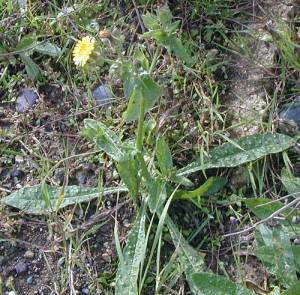 We started by walking down the lane beside the camp site, where we noticed the very heavy crop of fruits such as sloes and haws – these will provide plenty of food for winter thrushes, but there were very few birds to be seen today. Then we spent some time in the hide overlooking a lagoon, where we saw several interesting species, including waders, terns, dabchick and ducks. The highlights as far as I was concerned were the two Sandwich terns mingling with the large group of common terns, and the bar-tailed godwit feeding in the shallow water. Near the hide we also had a very good view of a stonechat, which was hanging on the wind before plunging down into the reeds to catch insects before flying up again and repeating the exercise. Most of the flowers had gone to seed, but there was ragwort (probably hoary, Senecio erucifolius) still in bloom along the path, as well as prickly oxtongue Picris echioides
with its characteristic leaves which have bristles emerging from large, pale
“blisters” (see photo right).
We started by walking down the lane beside the camp site, where we noticed the very heavy crop of fruits such as sloes and haws – these will provide plenty of food for winter thrushes, but there were very few birds to be seen today. Then we spent some time in the hide overlooking a lagoon, where we saw several interesting species, including waders, terns, dabchick and ducks. The highlights as far as I was concerned were the two Sandwich terns mingling with the large group of common terns, and the bar-tailed godwit feeding in the shallow water. Near the hide we also had a very good view of a stonechat, which was hanging on the wind before plunging down into the reeds to catch insects before flying up again and repeating the exercise. Most of the flowers had gone to seed, but there was ragwort (probably hoary, Senecio erucifolius) still in bloom along the path, as well as prickly oxtongue Picris echioides
with its characteristic leaves which have bristles emerging from large, pale
“blisters” (see photo right).
In the loose sand among the marram grass were a few plants of sea holly, and the michaelmas daisy-like sea aster and the pale pink sea rocket.
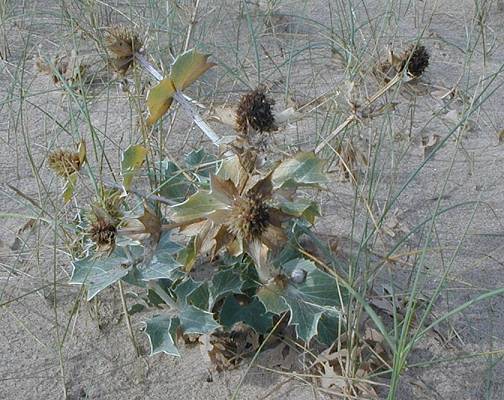
Sea holly (Eryngium maritimum)
 |
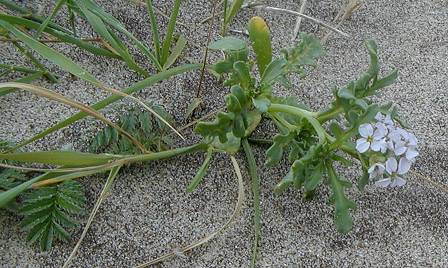 Sea aster (Aster tripolium) left, and Sea rocket (Cakile maritima) right |
We then drove down to the narrowest part of the spit, where the land is only about 50 yards across, with the open sea on one side and the Humber estuary on the other. We stopped here and had lunch, looking out over the mudflats on the estuary side, which were exposed as the tide was out. There were shelduck near the shore, with many gulls and waders further out, including redshank and a few grey plovers, very striking in their summer plumage of jet black underparts contrasting with the white band around the shoulders and across the face, and the mottled pale back; there were some individuals in winter plumage which looked quite different, being pale underneath. We also saw some dark young gannets flying past. On shore there were several kestrels scanning the bushes, either hovering low or sitting on the electricity wires. There were some interesting flowers here, including the yellow, rather wallflower-like wall rocket (Diplotaxis tenuifolia) – of which I failed to get a decent photo.
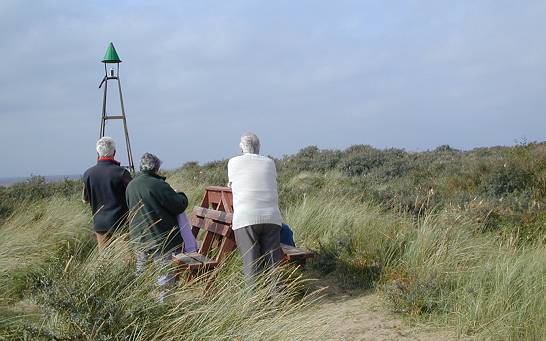
After lunch we drove down to the small group of houses near the lighthouse, then walked down to the point itself. Here the vegetation was dominated by scrub composed mainly of sea buckthorn, with some elder bushes, brambles and roses. Under these bushes several small plants were thriving, including these scarlet pimpernels and storksbill growing together.
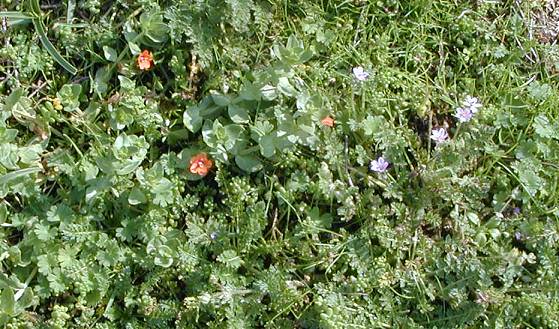
As we walked along the shore we spotted one seal bobbing on the surface out in the estuary, and we also saw a dead baby seal on the beach. At the seaward edge of the car park there were small scrubby plants of an Artemisia which was probably sea wormwood A. maritima (also known as Seriphidium maritmum), and growing in the cracks in the concrete the diminutive, pink-flowered sea spurrey. After watching the shipping in the Humber for a while Jim showed us the Heligoland Trap (a sort of giant funnel made of netting) which is used to trap birds for research purposes: they are ringed before being released. When we were there several small birds were inside, including a great tit and two chaffinches which Jim identified as continental visitors (the male had a plum-coloured breast) – both already ringed.
We noticed that many of the sea buckthorn bushes had silk webs on them. At first we thought these might have been spiders’ nests, but they seemed to have small caterpillars inside. Later research suggests these were the nests of brown-tip moths. We did not see many other insects, but there were several beautiful red admiral butterflies around, sometimes stopping to bask in the warm sunshine. These will be recently-emerged locally bred individuals, developing from eggs laid by immigrant first generation adults earlier in the summer.
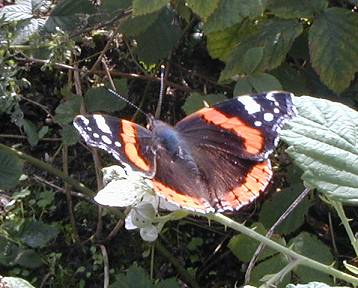
After this the party made its way back to a different hide for a short visit. The weather was looking distinctly gloomy by this stage, so we thanked Jim and made our way back to Ryedale.
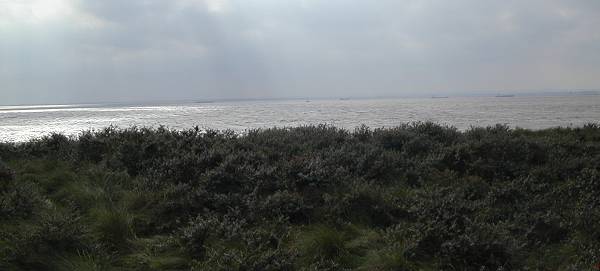
I did not make a complete list, but some of the more notable plants were:
| Common Name | Latin Name |
| Autumn hawkbit | Leontodon autumnalis |
| Hoary ragwort (?) | Senecio erucifolius |
| Prickly oxtongue | Picris echioides |
| Scarlet pimpernel | Anagallis arvensis |
| Sea aster | Aster tripolium |
| Sea buckthorn | Hippophae rhamnoides |
| Sea holly | Eryngium maritimum |
| Sea mayweed | Triplospermum maritimum |
| Sea rocket | Cakile maritima |
| Sea spurrey | Spergularia marina |
| Sea wormwood | A. maritima (Seriphidium maritimum) |
| Storksbill | Erodium cicutarium |
| Wall rocket | Diplotaxis tenuifolia |
notes from Jim Pewtress
On our walk up Beacon Lane towards the lagoon it was obvious that there were very few migrants other than Swallows and House Martins. At the lagoon we saw Little Grebes, Common and Sandwich Terns, Mallard, Curlew and Bar-tailed Godwit. Nice views of a Stonechat by the hide but on the way back along the beach there was nothing out to sea. We did however see several Rock Pipits. On the way down to the narrows for lunch we saw Shelduck and whilst having lunch a variety of waders were on the Humber estuary. These included a magnificent summer plumaged Grey Plover, with Oystercatchers, Redshank, Dunlin and other species too far away to see clearly without a telescope. We had a flypast of three immature Gannets and several of the larger gulls. At least 4 Kestrels were seen and one caught something in front of the car, retired to a telegraph wire to eat it, flew down again on to the roadside verge then flew off south.
At the Point there were plenty of Goldcrests, heard but not seen, but on the whole it was very quiet. Small party of Chaffinches in the Heligoland trap on the way back to the cars.
The final stop at the Canal Scrape was quiet but added Moorhen and Coot to the list as well as Grey Wagtail and I was lucky enough to hear a snatch of song from a Sedge Warbler.
A very enjoyable day. I feel a trip to Spurn is well worth the drive. Species seen were:
Swallow, House Martin, Sand Martin, Dunnock, House Sparrow, Pied Wagtail, Goldfinch, Robin, Magpie, Wood Pigeon, Blackbird, Reed Bunting, Cormorant, Little Grebe, Black-headed Gull, Common Gull, Great Black-backed Gull, Mallard, Curlew, Common Tern, Sandwich Tern, Turnstone, Ringed Plover, Dunlin, Bar-tailed Godwit, Skylark, Rock Pipit, Shelduck, Oystercatcher, Kestrel, Herring Gull, Redshank, Grey Plover, Golden Plover, Gannet, Goldcrest, Chaffinch, Great Tit, Coot, Moorhen, Meadow Pipit, Grey Wagtail and Sedge Warbler. 43 species.
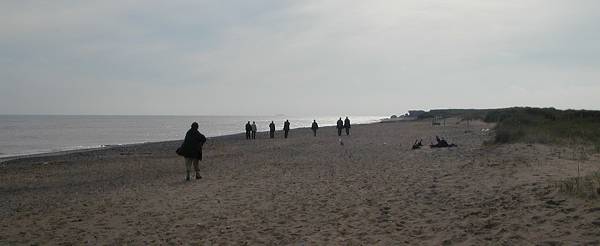
| Gill Smith September 2006 | Back to the Index page |
© Ryedale Natural History Society 2006 Photos © Gill Smith 2006